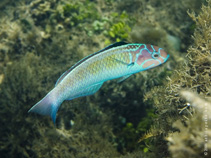| Family: |
Labridae (Wrasses), subfamily: Corinae |
| Max. size: |
13.3 cm SL (male/unsexed) |
| Environment: |
reef-associated; marine; depth range 0 - 60 m |
| Distribution: |
Western Atlantic: Brazil and its oceanic islands (Ref. 40101, 49354). |
| Diagnosis: |
|
| Biology: |
Generally a plankton-eater. Found on deep reefs (40-60 m), where it is recorded inside the lumen of tubular sponges (Ref. 39606). At Fernando de Noronha and Trindade Islands, groups of 10-450 initial-phase individuals clean other fishes in the water column close to the reef bottom and pinnacles (Ref. 36301, 49354). Also at Fernando de Noronha Archipelago, juveniles follow foraging green turtles (Chelonia mydas) and pick off particles stirred from the bottom by the turtle’s activity (Ref. 51385). Fish clients include about 20 species of surgeonfishes, damselfishes, parrotfishes, grunts, and even small groupers such as coneys. Occasionally, a coney (Cephalopholis fulva) preys on isolated Noronha wrasses out and away from the cleaning stations. Coastal individuals were never recorded cleaning. Strictly diurnal, this wrasse is one of the last reef fishes to emerge from nocturnal shelters and one of the first to retreat (Ref. 36301). Initial-phase individuals are predominantly dark-brown and white, whereas terminal-phase males are blue and purple. A group-spawner throughout the year, adult females form harems dominated by a few terminal-phase males. Pair spawning is also recorded for this wrasse (Ref. 49354). Traded as an aquarium fish at Ceará, Brazil (Ref. 49392). |
| IUCN Red List Status: |
Least Concern (LC); Date assessed: 12 April 2008 Ref. (130435)
|
| Threat to humans: |
harmless |
Source and more info: www.fishbase.org. For personal, classroom, and other internal use only. Not for publication.

